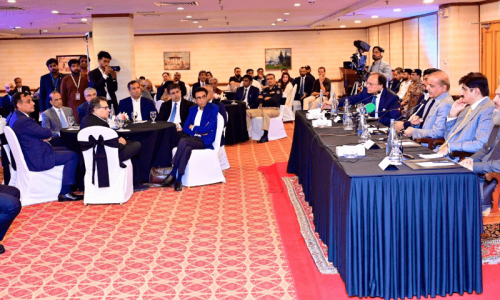
OVER the decades, Pakistan has profited by exporting its labour abroad, particularly to the resource-rich economies of the Gulf. This strategy, which has sent millions of semi-skilled blue-collar workers abroad, has led to a surge of remittance inflows.
These inflows have played a pivotal role in keeping afloat Pakistan’s economy by fulfilling a dire need for foreign currency. The end of the global commodity boom has led to tighter budgets in the Gulf, causing a dampening of demand for cheap foreign labour in Saudi Arabia, the United Arab Emirates, and other economies. This bodes ill for Pakistan, as lower demand for Pakistani labour will increase pressures on the local labour market and plateauing remittance flows will increase economic instability.
According to data made available by the Bureau of Emigration and Overseas Employment, over 9.3 million Pakistanis have travelled abroad for work since 1971. Punjab and Khyber Pakhtunkhwa have contributed the most number of workers — 4.46m and 2.23m respectively. Some 4.7m (51 per cent) of these 9.3m workers were either semi-skilled or unskilled. Since 2015, this proportion has jumped to almost 56pc (843,820 out of 1,511,022). This goes to show that faced with little to no opportunities at home, blue-collar workers have preferred to work abroad, often in horrifying conditions, in order to support their families.
Saudi Arabia and the UAE have historically been the main drivers of overseas employment, attracting almost 8m (83.8pc) of the total number of Pakistanis employed overseas since 1971. The effect of the commodity boom is clearly evidenced by this data, as the total number of workers going to Saudi Arabia and the UAE grew from 136,862 in 2004 to 849,736 in 2015.
Given the economic distress in Saudi Arabia and the UAE, remittance inflows will exhibit continued weakness.
Pakistan’s remittance inflows from these two countries show the positive effect of overseas employment. According to the data available on the State Bank of Pakistan’s website, the country’s remittance inflows from Saudi Arabia and the UAE almost doubled from $5.26 billion in 2010-2011 to $10.33bn in 2015-16. Inflows from these two countries contributed almost 52pc of the $19.9bn that came into Pakistan in 2015-2016.
This significant growth started to plateau in fiscal year 2016-2017 and is beginning to show significant weakness. Year-on-year growth in remittance inflows from Saudi Arabia and the UAE was 6pc and 3.16pc respectively. Two of the three months of the current fiscal year have shown negative year-on-year growth from Saudi Arabia and the UAE: -20.12pc in July and -12.24pc in September. Total remittance inflows from across the world reflect this trend as year-on-year remittances declined by 20.16pc in July and 9.34pc in September.
This weakness is a direct consequence of low oil prices and tighter budgets in the Gulf. Oil prices coupled with an expensive military campaign in Yemen has created a budget deficit of over 16pc of GDP in Saudi Arabia. This has forced the kingdom to cut salaries and cancel infrastructure projects. Saudi Arabia has witnessed a significant decline in foreign reserves during this period. Reserves have fallen to almost $550bn from a peak of over $700bn in 2014. The UAE has also seen its budget deficits widen to over 7pc of its GDP, and both countries have dipped into the international bond markets to raise money.
Given the economic distress in these two countries, Pakistan is set to experience continued weakness in its remittance inflows for the foreseeable future. As more jobs are lost, Pakistan will face both macroeconomic and social instability.
Lack of competitiveness has led to a continuous decline in exports — year-on-year exports were down 9pc in the first quarter of this fiscal year. In the past, this decline has been buffered by strong remittance growth. As remittances show weakness, there will be increased pressure on the country’s balance of payments and currency, especially since the government has relied on issuance of foreign debt to boost foreign exchange reserves.
Faced with bleak prospects abroad, thousands of semi-skilled and unskilled workers will return to the country. This will increase the pressure on a labour market that is already struggling to create a sufficient number of jobs. Furthermore, the families of these workers will see a drastic cut in their purchasing power as returning workers lose jobs that, in relative terms, paid a lot more in dirhams and riyals. Given that many of them lack sophisticated skills, these workers will enter a labour market that is already struggling with excess supply of labour.
A glimpse of the brewing crisis was visible in the past few weeks when thousands of Pakistani workers were left stranded in labour camps in Saudi Arabia. Economic distress in the kingdom meant that these people were not paid and refused to leave the country without being paid fair wages for their work. As the economic crisis deepens in Saudi Arabia, such issues could become the norm and test the diplomatic capacity of the government.
To mitigate the economic and social risks emanating from these developments, the government must begin to recognise the seriousness of the issue and respond proactively.
As I argued in a previous article, there is a dire need to improve the competitiveness of the economy. This will enable a growth of exports, thereby creating local jobs that can ease labour market distress. Rising exports will reduce the country’s reliance on remittance inflows and also create the type of jobs that can absorb returning Pakistanis.
A Rs200bn ‘bailout’ package seems like a step in the right direction, but a number of such steps are urgently needed to deal with an emerging economic crisis in Pakistan. It is imperative that Pakistan’s government fixes the structural issues plaguing the economy. Without such reforms, the country will face yet another macroeconomic crisis that will end with yet another IMF programme.
The writer is a South Asia analyst at Albright Stonebridge Group, in Washington DC.
Published in Dawn October 25th, 2016










































